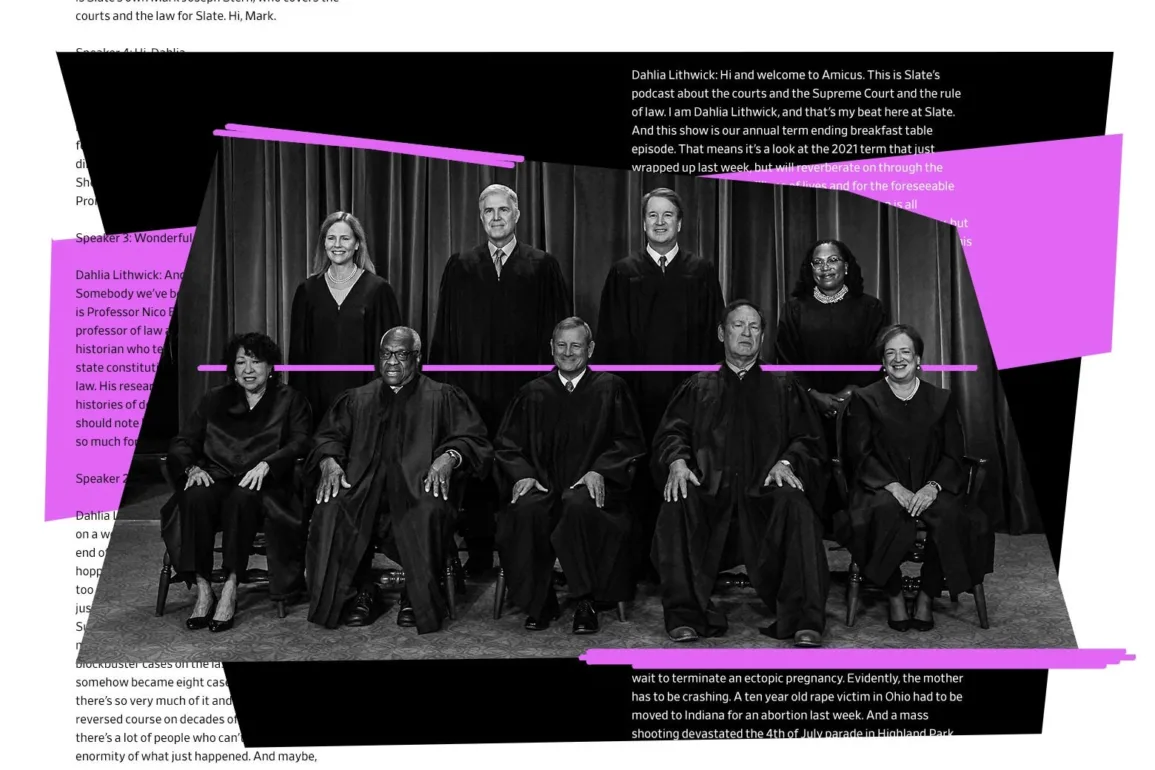This is part of Opinionpalooza, Slate’s coverage of the major decisions from the Supreme Court this June. We’re working to change the way the media covers the Supreme Court. Sign up for the pop-up newsletter to receive our latest updates, and support our work when you join Slate Plus.
The close of the 2023 term brought many useful but also several useless reflections on what to think about the permanent 6–3 conservative supermajority at the Supreme Court. Among the most dispiriting is the realization that the three preeminent dissenters for the foreseeable future will all be women. One of those women is the first African American woman to sit on the high court; the other is the first Latina. That they will devote the next mystery-number of years and decades to writing dissents is simply a truth universally acknowledged. That the dissents this year happened to be phenomenally well written and persuasive is worth pondering as well.
Another revelation that arises from the final days of the term is that when it comes to women and judicial opinion writing, three is indeed a magic number. As Justice Ruth Bader Ginsburg used to say, it was never fun writing dissents (or sitting in conference) (or speaking in law school) as the only woman and thus being tasked with speaking on behalf of all womankind. Research has shown that you need three women sitting on a board before they all begin to be comfortable speaking in their own voices, and this year, it’s become clear that the rule might apply to SCOTUS, too. Justices Sonia Sotomayor, Elena Kagan, and Ketanji Brown Jackson each displayed a unique and coherent way of thinking about the court, the law, history, and judicial reasoning in their dissents. As the final opinions came down, it became plain that while they may sometimes work in different lanes, the messages are richer for coming in tandem.
Justice Sotomayor has long been called “the People’s Justice” (before that moniker became, weirdly, affixed to Clarence Thomas, last week)—and not just because she sells her books at Walmart and throws out first pitches at Yankees games, but because she has become the voice for the kinds of people who are not visible to the justices who now write the majority opinions. Whether it’s her response to a warrantless traffic stop case from 2016 or her sharp dissent when Texas’ S.B. 8 abortion vigilante law was decided on the “shadow docket,” Sotomayor purposefully shines a light on the real people who will be harmed by a policy blithely signed into law by the majority justices. As Elie Mystal put it at the end of last term, the jurists driving the agenda for the six-justice supermajority “are willing to ignore the practical impact of their decisions in furtherance of their ideological fever dreams.” In contrast, Sotomayor’s opinions increasingly begin and end by “focusing on the people involved in a dispute instead of on the ideological and political goals of the litigants.”
An illustrative example: In her dissenting opinion in 303 Creative, the case allowing a website designer who wants to deny services to same-sex couples to be exempted from Colorado’s public accommodations law, Sotomayor manages to see past the hypothetical worries of the web designer and registers instead that “around the country, there has been a backlash to the movement for liberty and equality for gender and sexual minorities. New forms of inclusion have been met with reactionary exclusion. This is heartbreaking.” Whereas Justice Gorsuch can’t imagine anyone’s dignitary interests beyond those of the web designer, Lorie Smith, Sotomayor reminds us that the beating heart of public accommodations protections is “to vindicate the deprivation of personal dignity that surely accompanies denials of equal access to public establishments.” She is capable of opening the narrative lens wide enough to ask her readers to understand that we don’t let businesses discriminate because “this ostracism, this otherness, is among the most distressing feelings that can be felt by our social species.” It’s an extraordinarily perceptive line.
Sotomayor can make these claims because she deliberately tries to imagine the breadth of human experience. As she lays out the history of public accommodations law, she notes that it swept in race, then gender, then later “opened its eyes to another injustice. People with disabilities … [who] had been excluded from many areas of public life.” Sotomayor is able to imagine the facts of this case applying broadly to denial of funeral services to same-sex couples, and refusals to photograph interracial kids. Justice Gorsuch pooh-poohs all that away with a smug “But those cases are not this case.” OK—but what about this case, the Michigan hair-salon owner taking 303 Creative to mean she can legally discriminate against transgender people (and even compare them to pets in so announcing)? It hasn’t even been two weeks since the ruling that opened these floodgates. Sotomayor wrote for the dignitary interests of all those customers, for all of these cases. Gorsuch wrote for himself and Lorie Smith.
Elena Kagan has also found a powerful lane for herself: as keeper of the court’s legitimacy flame. It was she who cautioned last fall that the court was harming itself in the public eye, and it was she who quickly earned a slap-back from the chief justice for it. Kagan thinks about the court in institutional ways that transcend any single case, and her dissent in Biden v. Nebraska, the court’s big student debt relief case, highlighted the structural role she’s assigned to herself. The court’s decision didn’t just have measurable impacts on millions of student debtors. It also harmed the court itself. As she put it in her dissent, the majority’s arrogation of the power to decide what Congress has and has not delegated:
is a major problem not just for governance, but for democracy too. Congress is of course a democratic institution; it responds, even if imperfectly, to the preferences of American voters. And agency officials, though not themselves elected, serve a President with the broadest of all political constituencies. But this Court? It is, by design, as detached as possible from the body politic. That is why the Court is supposed to stick to its business—to decide only cases and controversies and to stay away from making this Nation’s policy about subjects like student-loan relief.
Her words are biting, by design: “the majority overrides the combined judgment of the Legislative and Executive Branches, with the consequence of eliminating loan forgiveness for 43 million Americans.” What sets the chief off is her (correct) assessment that “In every respect, the Court today exceeds its proper, limited role in our Nation’s governance.” Roberts again slapped back in his majority opinion: “It has become a disturbing feature of some recent opinions to criticize the decisions with which they disagree as going beyond the proper role of the judiciary.” As Rick Hasen explains here, when courts arrogate unto themselves the power to judge other judges’ judgment, it’s not unreasonable for Kagan, or the public in general, to wonder what still limits them. This decline in public confidence keeps Kagan up at night. She continues to say as much in coolly principled ways. Until now, the response from the justices in the supermajority has been more of the same shoot-the-messenger stuff they direct at the press. This does not appear to be helping with the legitimacy issue, and Kagan ensures that it is not brushed away.
Finally, Justice Ketanji Brown Jackson has chosen to carve out her own path in terms of taking seriously the project of originalism, history, and textualism, and has set herself the task of becoming a meaningful voice for progressive originalism. Her dissent in Students for Fair Admissions v. Harvard and SFFA v. University of North Carolina, the affirmative action cases, was a master class in both history and textualism. “At the risk of stating the blindingly obvious,” she wrote, “the Fourteenth Amendment was intended to undo the effects of a world where laws systematically subordinated Black people and created a racial caste system.”
She continued, refuting the infinite silliness of codifying the ahistoric notion of “colorblindness” as the North Star of the Reconstruction Amendments:
Our country has never been colorblind. Given the lengthy history of state-sponsored race-based preferences in America, to say that anyone is now victimized if a college considers whether that legacy of discrimination has unequally advantaged its applicants fails to acknowledge the well-documented “intergenerational transmission of inequality” that still plagues our citizenry.
Jackson has used her first term at the high court to take on the conservative project of textualism and history on its own terms. She argues that the historic evidence overwhelmingly supports her own methodology and not that of Clarence Thomas or the others who seek to bend history to fit their desired political outcomes. By pitting herself against Clarence Thomas’ bizzarro take on text and history (“Justice Thomas’s prolonged attack … responds to a dissent I did not write in order to assail an admissions program that is not the one UNC has crafted”), she rejects his claim that the only possible effect of affirmative action is victimhood, stigma, and shame.
To be sure, all of these three dissenters join in other dissents, and each has pulled from strains of analysis around the suffering of real people, the importance of institutional humility and legitimacy, and the use of text and history, throughout the term and over many years. But to the extent they are each surfacing pointed concerns that are often glossed over by the majority, they are all giving voice to imperative public concerns.
At the close of yet another depressing term, the results of which we will now all grapple with, and adjust and digest, it’s understandable to wonder at the very purpose of penning a dissent, and the staggering visual of three of the court’s historic four women, forced to write from a position of relative powerlessness and loss. But what these women are doing—what dissents have always served to do—involves laying down historical markers for a to-be-determined future, in which their submerged ideas about justice, dignity, equality, history, and opportunity might begin to snap back. This is long and often thankless work, but centuries of labor suggest that it is undoubtedly worthwhile. They are postcards to our better angels, and signposts of where we’ve come from and where we might go.



